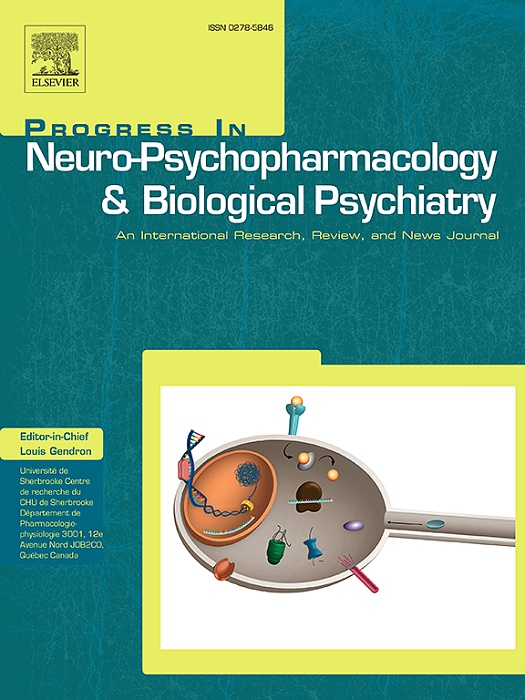Social isolation intensifies adgrl3.1-related externalizing and internalizing behaviors in zebrafish
IF 5.3
2区 医学
Q1 CLINICAL NEUROLOGY
Progress in Neuro-Psychopharmacology & Biological Psychiatry
Pub Date : 2024-11-12
DOI:10.1016/j.pnpbp.2024.111193
引用次数: 0
Abstract
Externalizing disorders (EDs) are characterized by outward-directed behaviors such as aggression and hyperactivity. They are influenced by gene-environment interactions, yet our understanding of the genetic predispositions and environmental contexts that give rise to them is incomplete. Additionally, people with EDs often exhibit comorbid internalizing symptoms, which can complicate the clinical presentation and treatment strategies. Following on from our previous studies, we examined genes x environment interaction as a risk factor for EDs by looking at internalizing and externalizing behaviors after social isolation. Specifically, we subjected adgrl3.1 knockout zebrafish — characterized by hyperactivity and impulsivity — to a 2-week social isolation protocol. We subsequently assessed the impact on anxiety-like behavior, abnormal repetitive behaviors, working memory, and social interactions. Genotype-specific additive effects emerged, with socially isolated adgrl3.1 knockout fish exhibiting intensified comorbid phenotypes, including increased anxiety, abnormal repetitive behaviors, reduced working memory, and altered shoaling, when compared to WT fish. The findings demonstrate that genetic predispositions interact with environmental stressors, such as social isolation, to exacerbate both externalizing and internalizing symptoms. This underlines the necessity for comprehensive diagnostic and intervention strategies.
社会隔离会加剧斑马鱼与adgrl3.1相关的外化和内化行为
外化障碍(Externalizing Disorders,EDs)的特征是外向行为,如攻击和多动。它们受到基因与环境相互作用的影响,但我们对导致这些疾病的遗传倾向和环境背景的了解并不全面。此外,ED 患者往往合并有内化症状,这可能会使临床表现和治疗策略复杂化。在之前研究的基础上,我们通过观察社会隔离后的内化和外化行为,研究了作为 ED 风险因素的基因与环境的相互作用。具体来说,我们对adgrl3.1基因敲除斑马鱼--以多动和冲动为特征--进行了为期两周的社会隔离实验。随后,我们评估了其对焦虑样行为、异常重复行为、工作记忆和社会交往的影响。与 WT 鱼相比,被社会隔离的 adgrl3.1 基因敲除鱼表现出更强的合并表型,包括焦虑增加、异常重复行为、工作记忆减弱和浅滩行为改变。研究结果表明,遗传易感性与社会隔离等环境压力相互作用,加剧了外化和内化症状。这凸显了综合诊断和干预策略的必要性。
本文章由计算机程序翻译,如有差异,请以英文原文为准。
求助全文
约1分钟内获得全文
求助全文
来源期刊
CiteScore
12.00
自引率
1.80%
发文量
153
审稿时长
56 days
期刊介绍:
Progress in Neuro-Psychopharmacology & Biological Psychiatry is an international and multidisciplinary journal which aims to ensure the rapid publication of authoritative reviews and research papers dealing with experimental and clinical aspects of neuro-psychopharmacology and biological psychiatry. Issues of the journal are regularly devoted wholly in or in part to a topical subject.
Progress in Neuro-Psychopharmacology & Biological Psychiatry does not publish work on the actions of biological extracts unless the pharmacological active molecular substrate and/or specific receptor binding properties of the extract compounds are elucidated.

 求助内容:
求助内容: 应助结果提醒方式:
应助结果提醒方式:


